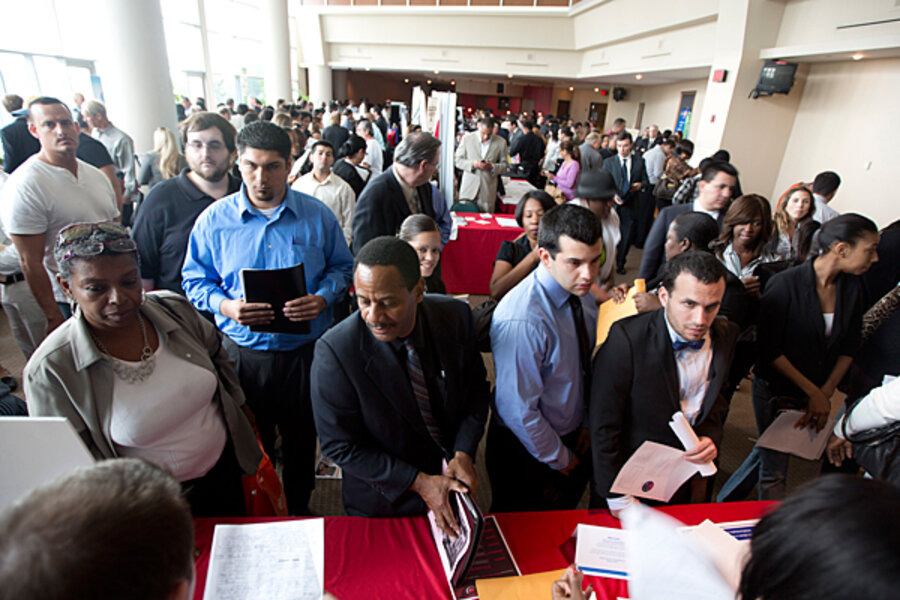January jobs report: Will 'OK' jobs market make politicians complacent?
US employers added 157,000 new jobs in January, an unexciting but solid total that helped to push the Dow Jones Industrial Average above the 14,000 level Friday morning.
A twice-monthly indicator of consumer confidence also rose Friday.
All this is welcome news, but it raises a question: With just about four weeks to go in high-stakes talks on fiscal policy, will these marketplace signals give politicians in Washington a false sense of security – a kind of license to engage in brinkmanship or do nothing?
It’s an important query, because the economy remains in a fairly fragile condition, and the potential impact of the fiscal decisions on the economy are significant. In recent years, both America and European nations have seen some political standoffs resolved only after the marketplace sends signals of urgency.
If the sharply divided Congress can’t agree to an alternative plan by March 1, then automatic federal spending cuts are scheduled to go into effect. Many economists believe this would weigh on job growth.
This comes as the economy is already moving slowly. Gross domestic product failed to grow in the fourth quarter (declining at a 0.1 percent annual rate), the Commerce Department reported this week. Economists are forecasting a slender growth rate of 1.6 percent for the current quarter.
American workers have been hit this month by a roughly 2 percent pay cut, due to the expiration of a temporary payroll-tax break at year's end. And despite employer job creation in January, the unemployment rate ticked upward a notch, to 7.9 percent, as more people joined the labor force.
The positive news is that the private sector has shown enough strength to keep chugging along in the past few months, despite lots of uncertainty surrounding whether federal taxes would rise (an early-January deal kept the tax hikes to a minimum) and whether the federal budget will face meaningful cuts (still to be determined).
In fact, the Labor Department said Friday that job growth was actually stronger in the final two months of 2012 than had been initially reported – a fact that helped to push stock prices higher even though the January job total didn’t exceed forecasts.
But here’s where the risk of complacency comes in.
The economy may not have fully felt the impact that the payroll-tax hike will have on consumer spending – since that change in take-home pay is only a few weeks old. And the “sequester” (automatic spending cuts) could shave as much as a percentage point from the pace of GDP growth in the second and third quarter.
Investors and the general public breathed a justified sigh of relief early in January, when Congress and President Obama reached a deal that averted many of the tax hikes scheduled to hit US consumers.
But Robert Dye, chief economist at the banking firm Comerica, warns that many fiscal issues are still outstanding, with Congress seeking a difficult balance between sustaining growth and putting the federal budget on sounder footing by reducing future deficits.
“Right now it is reasonable to assume that a significant portion of the $110 billion sequester will happen,” he wrote in an analysis published in January by Blue Chip Economic Indicators. “It is reasonable to assume that the total fiscal drag from increased taxes and reduced spending will be in the neighborhood of 2 percent of GDP, primarily felt in the first half of 2013.”
The result, Mr. Dye says, could be an economy that grows very little (perhaps at a 1 percent pace) or not at all for the first half of the year. That would leave the economy much more vulnerable than usual to the risk of recession.
If more optimistic economists are correct, the outlook may be brighter. In the Blue Chip survey of more than 50 forecasters, some see the economy growing at a pace higher than 2 percent in the first quarter, rising to 3 percent later in the year.
That outlook banks on a continuing steady rise in activity within the private sector (which accounts for about 84 percent of all jobs) outweighing the braking effects of tighter fiscal policy.
Moreover, some economic analysts argue that the sequester, cutting federal spending by about $100 billion a year, doesn’t pose a risk to the job market. The conservative editorial board at The Wall Street Journal, for example, opined Thursday that the spending cuts “will help business and investor confidence by finally showing that government can restrain itself – at least a little and however crudely.”
Many Republican lawmakers appear ready to allow the spending cuts to go forward, in part based on similar reasoning that the economy would benefit more from government restraint.
Even some conservative economists, however, warn that spending cuts could hurt GDP in the short run. “Congress and the president need to avoid excessive austerity with respect to changes in fiscal policy this year,” John Makin of the American Enterprise Institute argued in a recent report.
The sequester could result in job cuts on both federal and private-sector payrolls, as the government would cut back on procurement from defense contractors such as Lockheed Martin.
That doesn’t mean long-run deficits should be ignored. Mr. Makin and many other economists argue for taking steps now to reform entitlement programs, in a bid to head off a dangerous rise in national debt.
All this leaves policymakers with a bit of a tightrope to walk.
If Congress does too little to address the debt risk, and there is too much partisan gridlock, credit rating agencies could downgrade the quality of US Treasury debt. But the 2013 spending cuts, if they happen, could dampen job growth that's not exactly robust.







